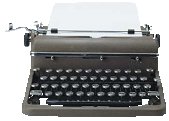Writing and Reporting
Writing for newsletters can be informal or formal but always focused on audience interests. Budget is a key factor
when deciding what kind of newsletter to produce. Remember - it's the content, not appearance that matters most!
REPORTING SKILLS
- Useful Information
Tell readers something they don't already know.
- Angle
Find an angle that sets the organization apart from similar newsletters.
WRITING SKILLS
- Mission
What should the newsletter accomplish? Should it inform or solicit response?
Approach production with that in mind.
- Grammar
Standard rules of grammar, punctuation and spelling always apply (make sure more than one set of eyes sees
the newsletter before distribution). Stylebooks are helpful. Sentences for newsletters usually consist of a subject,
verb and object. Adjectives, adverbs and compound sentences are rarely used.
- Length
Use the KISS method - Keep It Short and Simple!
- Facts
Include the facts, but make it interesting. Use the "who, what, when, where, why and how" approach to
writing. However, while copy is important, make sure to not crowd the newsletter with words only – headlines,
indentations and generous paragraphing can make a newsletter more pleasing to the eye.
What do you want to accomplish with your newsletter?
Graphic Design
Computer software has motivated people and organizations to produce their own materials instead of hiring a
designer or graphic artist. New programs make the process easier than ever:
GENERAL STYLE
- Specifics
How many pages will there be?
What kind of visual frame will hold the copy and other information?
- Consistency
The design format should be consistent with the logo and other printed materials (letterhead/business cards),
but distinctive from other organizationsí newsletters. Once an acceptable format is found, save the template
on the computer and change the copy for each issue. Consistency is the key – it creates a visual identity for a
newsletter!

